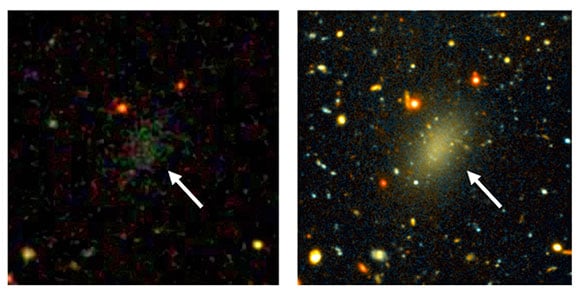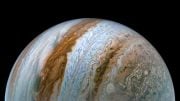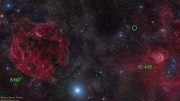
The image on the left is a wide view of the galaxy Dragonfly 44, taken with the Gemini North telescope using the Gemini Multi-Object Spectrograph (GMOS). The close-up on the right reveals the large, elongated galaxy, and the halo of spherical cluster of stars around the galaxy’s core, similar to the halo that surrounds the Milky Way. (Images by Pieter van Dokkum, Roberto Abraham, Gemini Observatory/AURA)
An international team of astronomers has discovered a massive galaxy that consists almost entirely of dark matter.
The galaxy, Dragonfly 44, is located in the nearby Coma constellation and had been overlooked until last year because of its unusual composition: It is a diffuse “blob” about the size of the Milky Way, but with far fewer stars.
“Very soon after its discovery, we realized this galaxy had to be more than meets the eye. It has so few stars that it would quickly be ripped apart unless something was holding it together,” said Yale University astronomer Pieter van Dokkum, lead author of a paper in the Astrophysical Journal Letters.
Van Dokkum’s team was able to get a good look at Dragonfly 44 thanks to the W.M. Keck Observatory and the Gemini North telescope, both in Hawaii. Astronomers used observations from Keck, taken over six nights, to measure the velocities of stars in the galaxy. They used the 8-meter Gemini North telescope to reveal a halo of spherical clusters of stars around the galaxy’s core, similar to the halo that surrounds our Milky Way galaxy.
Star velocities are an indication of the galaxy’s mass, the researchers noted. The faster the stars move, the more mass its galaxy will have.
“Amazingly, the stars move at velocities that are far greater than expected for such a dim galaxy. It means that Dragonfly 44 has a huge amount of unseen mass,” said co-author Roberto Abraham of the University of Toronto.
Scientists initially spotted Dragonfly 44 with the Dragonfly Telephoto Array, a telescope invented and built by van Dokkum and Abraham.
Dragonfly 44’s mass is estimated to be 1 trillion times the mass of the Sun, or 2 tredecillion kilograms (a 2 followed by 42 zeros), which is similar to the mass of the Milky Way. However, only one-hundredth of 1% of that is in the form of stars and “normal” matter. The other 99.99% is in the form of dark matter — a hypothesized material that remains unseen but may make up more than 90% of the universe.
The researchers note that finding a galaxy composed mainly of dark matter is not new; ultra-faint dwarf galaxies have similar compositions. But those galaxies were roughly 10,000 times less massive than Dragonfly 44.
“We have no idea how galaxies like Dragonfly 44 could have formed,” said Abraham. “The Gemini data show that a relatively large fraction of the stars is in the form of very compact clusters, and that is probably an important clue. But at the moment we’re just guessing.”
Van Dokkum, the Sol Goldman Family Professor of Astronomy and Physics at Yale, added: “Ultimately what we really want to learn is what dark matter is. The race is on to find massive dark galaxies that are even closer to us than Dragonfly 44, so we can look for feeble signals that may reveal a dark matter particle.”
Additional co-authors are Shany Danieli, Allison Merritt, and Lamiya Mowla of Yale, Jean Brodie of the University of California Observatories, Charlie Conroy of Harvard, Aaron Romanowsky of San Jose State University, and Jielai Zhang of the University of Toronto.
Reference: A High Stellar Velocity Dispersion and ~100 Globular Clusters for the Ultra Diffuse Galaxy Dragonfly 44″ by Pieter van Dokkum, Roberto Abraham, Jean Brodie, Charlie Conroy, Shany Danieli, Allison Merritt, Lamiya Mowla, Aaron Romanowsky and Jielai Zhang, 25 August 2016, The Astrophysical Journal Letters.
DOI: 10.3847/2041-8205/828/1/L6
arXiv:1606.06291









There are some very complicated issues of galaxy formation. Unfortunately, here is the same problem as with the stars. The origin of galaxies remains unclear, in spite of huge activity in the field. What the “formation” means? It means that we have the material that is assembling into galaxies.
For a more in-depth understanding of any subject nothing is more helpful than expanding the horizons, and shifting the perspective and focus of that matter or topic. In this case of Dragonfly 44 (How was that name arrived at?) we need to consider its environment in the context of the Coma cluster of galaxies. And, we may as well include the sibling Leo Cluster (Abell 1367). To facilitate such a grand view a nod towards the origins of all these constructions is required; back to those early universe filaments of energy/mass. If you are intolerant of contrarian theories, I suggest you read no further.
The Omega Body hypothesis –
After some evolution and continuing processing, early universe filaments of energy and mass segmented into units of all mass sizes, called Omega bodies. These were flung for all distances and at various speeds. During flight through space each gathered a volume/amount of dark matter and ‘real matter’ according to its mass size, its velocity, the (varying) density of space along that trajectory, and the duration of its journey. This accumulation of matter, which in many cases was enormous, served to slow the forward progress of the Omega body. Closely resembling now what we call a black hole each then set about the construction of a galaxy of stars, drawing upon that cache of collected matter. In all cases the resulting galaxy is elliptical in form. (Ellipticals are not formed by the merger of spiral galaxies; though some mergers may resemble ellipticals.) The progeny of a maturing elliptical galaxy are spiral and other galaxies. (A scenario too involved to include here.)
As per Dragonfly 44 –
Regressing. When that ancestral filament segmented the freed parts, though separated, stayed closely together. Those several Omega bodies with their combined mass(es) collected an unfathomable amount, or halo, of matter. Which early on slowed the progress of this collective.
[Which is not true in the case of the extended Local Group of galaxies out to about 20 million light years from here. That lone Omega body upon arriving in this area split into two parts which in time became the elliptical galaxies Centaurus A and Maffei 1, the progenitors of all the spirals in this locale. The point being made is, the much, much heavier conglomeration that was to become the Leo and the Coma clusters stopped their forward progress much sooner than did the (our) local branch of the Virgo group. That accounts for why those clusters are so much more advanced in their progress towards reassembly of all the original parts. It is the destiny of all the now distended parts of an early universe filament to return to roughly the site of their origins. Again, our family of galaxies along with others will join the Virgo group for a colossal reunion, but much later than other clusters like Coma because taking so long to get here we will have a late start.]
Getting to Dragonfly 44 and all the other parts of the Coma cluster –
As noted, several Omega bodies maintained something like a flight formation until reaching their destination. Then one group which had always maintained a slight separation went off and formed the Leo family of galaxies. It took with it approximately half of the asymmetrical halo of ‘goodies’. The remainder of that cloud of matter stayed with what would become the Coma family of galaxies, a foundering trio of Omega bodies. The two centered large elliptical galaxies are NGC 4874 and NGC 4889, plus a third smaller galaxy NGC4839 just outside the core group. These three Omega bodies, become elliptical galaxies, spawned thousands of spiral shaped galaxies, plus many lessor entities. (A story too long to include here.)
That gravity bonded halo of dark and real matter (baryons) –
Densities of each form of matter varied in that cloud, not uniform or isometric, and the overall shape of that halo was asymmetric. Partly due to encounters of varying densities during transition through space. Additionally, a factor too little appreciated, the characteristic of momentum is different between dark matter and all other matter, causing space to form ripples or density waves as these may be propelled by some gravitating body. (Expounded upon in the book.) Thus, there are alternating strata and pockets of lean and rich matter. Secondary and tertiary formation galaxies (the ellipticals are primary) depending upon where they happen to form within the maternal environment may have slim or abundant supplies of matter to draw upon for star formation. (Other factors necessary for star formation not discussed here.)
Finally, Dragonfly 44 –
All collections of stars must have a nucleating presence, usually a strong gravitating source, as far as is known, a black hole. That black hole(s) may sire many stars, or only a few, or none (a dark galaxy) depending upon the composition of its small or large share of that primordial halo of matter. Smaller spiral galaxies, peculiar, and dwarf galaxies lack growth because, one, they were located in a deficient of materials part of the overall halo, and/or two, they could not compete gravitationally locally for star making supplies with the ‘big boys’. Some galaxies experience a spurt of growth, using up their supplies (baryons), such as Dragonfly 44’s ambitious construction of globular clusters, then decline in star formation. Perhaps this is the case for Dragonfly 44. Even so, many a moribund galaxy has experienced renewed growth, due to inflows of fresh materials, or a change in conditions which can accelerate within the close confines of a cluster. Dragonfly 44 has a promising, perhaps short, future.